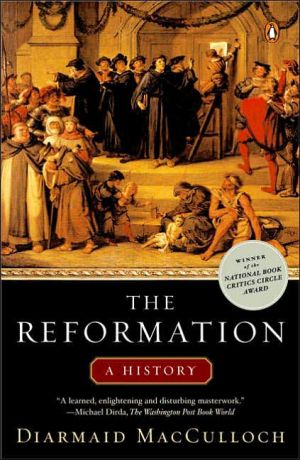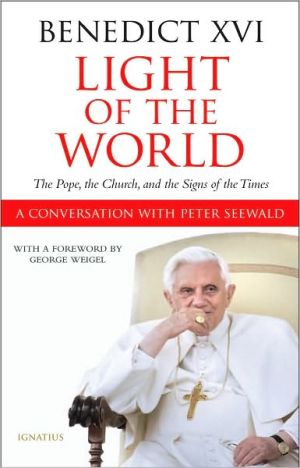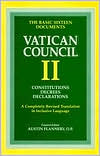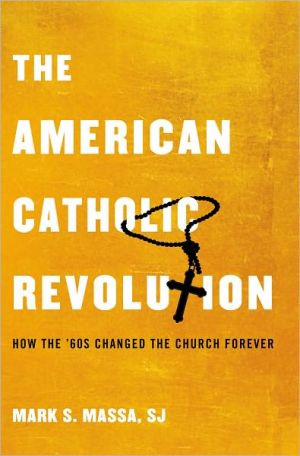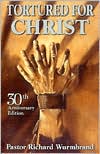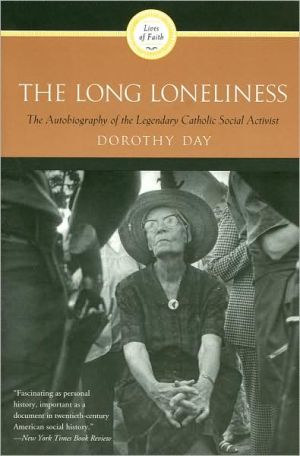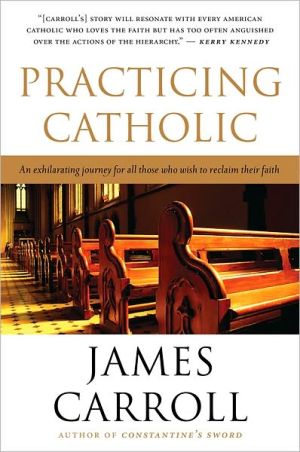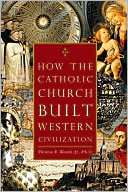The Reformation: A History
The Reformation and the Counter-Reformation it provoked are one of the great discontinuities in European and world history. The dramatic changes that began when Martin Luther proclaimed his ninety-five theses in Wittenberg in 1517 were of a different order to anything that had gone before. In the following two hundred years, the Christian world broke apart and the nature not just of religion but also of politics, thought, society and culture all changed utterly. The course of history down to...
Search in google:
The Reformation and Counter-Reformation represented the greatest upheaval in Western society since the collapse of the Roman Empire a millennium before. The consequences of those shattering events are still felt today—from the stark divisions between (and within) Catholic and Protestant countries to the Protestant ideology that governs America, the world's only remaining superpower. In this masterful history, Diarmaid MacCulloch conveys the drama, complexity, and continuing relevance of these events. He offers vivid portraits of the most significant individuals—Luther, Calvin, Zwingli, Loyola, Henry VIII, and a number of popes—but also conveys why their ideas were so powerful and how the Reformation affected everyday lives. The result is a landmark book that will be the standard work on the Reformation for years to come. The narrative verve of The Reformation as well as its provocative analysis of American culture's debt to the period will ensure the book's wide appeal among history readers. The Washington Post - Michael Dirda The Reformation is a learned, enlightening and disturbing masterwork, and likely to become the standard one-volume history. Not least among its virtues, the book faithfully reflects the variousness and confusion of the times, when it was hard to distinguish the madman from the future saint.
Introduction\ Who or what is a Catholic? This Greek word has become one of the chief battlegrounds in western Latin Christianity, for it is used in different ways that outside observers of Christian foibles find thoroughly confusing. The word "Catholic" is the linguistic equivalent of a Russian doll. It may describe the whole Christian Church founded two thousand years ago in Palestine, or the western half of the Church that split from mainstream eastern Christianity a thousand years ago, or that part of the western half that remained loyal to the bishop of Rome (the pope) after the sixteenth century, or a Protestant European Christian who thought that the bishop of Rome was the Antichrist, or a modern Anglo-Catholic faction within the Anglican Communion. How can the word describe all of these things and still have any meaning? I have written this book about the sixteenth-century Reformation in part to answer that question. The Reformation introduced many more complications to the word; in fact, there were very many different Reformations, nearly all of which would have said that they were aimed simply at recreating authentic Catholic Christianity. For simplicity's sake I will take for granted that this book examines multiple Reformations, some of which were directed by the pope. From now on I will continue to use the shorthand term "Reformation," but readers should note that this is often intended to embrace both Protestantism and the religious movements commonly known as Tridentine Catholicism, the Catholic Reformation, or the Counter-Reformation, which revitalized part of the old Church that remained loyal to the pope.\ "Catholic" is clearly a word a lot of people want to possess. By contrast, it is remarkable how many religious labels started life as a sneer. The Reformation was full of angry words: "Calvinist" was at first a term of abuse to describe those who believed more or less what John Calvin believed; the nickname gradually forced out the rival contemptuous term "Picard," which referred to Calvin's birthplace in Noyon, in Picardy.1 No Anabaptists ever described themselves as Anabaptist, since "Anabaptist" means "rebaptizer," and these radical folk believed that their adult baptism was the only authentic Christian initiation, with infant baptism signifying nothing. Even that slippery term "Anglican" appears to have been first spoken with disapproval by King James VI of Scotland, when in 1598 he was trying to convince the Church of Scotland how unenthusiastic he was for the Church of England.2\ One of the most curious usages is the growth of the word "Protestant." It originally related to a specific occasion, in 1529, when at the Holy Roman Empire's Diet (imperial assembly) held in the city of Speyer, the group of princes and cities who supported the programs of reformation promoted by Martin Luther and Huldrych Zwingli found themselves in a voting minority: To keep their solidarity, they issued a protestatio, affirming the reforming beliefs that they shared. The label "Protestant" thereafter was part of German or imperial politics for decades, and did not have a wider reference than that. When the coronation of little King Edward VI was being organized in London in 1547, the planners putting in order the procession of dignitaries through the city appointed a place for "the Protestants," by whom they meant the diplomatic representatives of these reforming Germans who were staying in the capital.3 Only rather later did the word gain a broader reference. It is therefore problematic to use Protestant as a simple description for sympathizers with reform in the first half of the sixteenth century, and the reader will find that often in this book I use a different word, "evangelical." That word has the advantage that it was widely used and recognized at the time, and it also encapsulates what was most important to this collection of activists: the good news of the Gospel, in Latinized Greek, the evangelium.\ Reformation disputes were passionate about words because words were myriad refractions of a God whose names included Word: a God encountered in a library of books, itself simply called the Book-the Bible. It is impossible to understand modern Europe without understanding these sixteenth-century upheavals in Latin Christianity. They represented the greatest fault line to appear in Christian culture since the Latin and Greek halves of the Roman Empire went their separate ways a thousand years before; they produced a house divided. The fault line is the business of this book. It is not a study of the whole of Europe as a whole: It largely neglects Orthodox Europe, the half or more of the continent that stretches from Greece, Serbia, Romania, and Ukraine through the lands of Russia as far east as the Urals. I will not deal with these except when the Orthodox story touches on or is intertwined with that of the Latin West. There is a simple reason for this: So far, the Orthodox churches have not experienced a Reformation. Back in the eighth and ninth centuries many of them were convulsed by an "iconoclastic controversy," which hinged on one of the great issues to reappear in the sixteenth-century Reformation. But in the case of the Orthodox, the status quo was restored and not partially overthrown as it was in the West. We will return to this issue of images frequently in the course of this book.\ My subject, then, is the Church that, when united, might most accurately be described (though clumsily and in narrow technical ecclesiological jargon) as the Western Church of the Latin Rite; I shall more commonly call it the western Church or the Latin Church, and refer to the culture that it sustained as Latin or western Christendom. Latin was inherited from the western Roman Empire formally dismantled in 476; Latin remained the language that united the peoples of this society, and in which they made their official approaches to God. During the sixteenth century this western society, previously unified by the pope's symbolic leadership and by possession of that common Latin culture, was torn apart by deep disagreements about how human beings should exercise the power of God in the world, arguments even about what it was to be human. It was a process of extreme physical and mental violence. The historian of the German Reformation Peter Matheson compares the effect to the strategy of Berthold Brecht in his plays: Brecht talked of "alienation," verfremdung, a process of making the familiar unfamiliar in order to shock his theater audiences into taking control of their perceptions of what was going on in the drama. The reformers, suddenly finding the pope to be the devil's agent and the miracle of the Mass the most evil moment in their earthly experience, would have known exactly what Brecht was trying to say.4\ The resulting division between Catholic and Protestant still marks Europe west of the lands of Orthodox (Greek, Russian, and oriental) Christianity, in a host of attitudes, assumptions, and habits of life that distinguish, for instance, the remaining territories of Protestant Prussia from neighboring Catholic Poland, or the Protestant Netherlands from the Catholicism of the modern kingdom of Belgium. Sometimes the two communities nurse ancient grievances side by side, as in Northern Ireland. The Protestant communities, which for a variety of reasons and motives cut themselves off from Rome, also cut themselves off from many possible devotional roads to God, because they saw such routes as part of Roman corruption. In one sense, therefore, the Reformation conflicts stifled diversity. Rome closed down options by the decisions of the Council of Trent; Protestants, too, were anxious to weed out rival versions of Protestantism where princes and magistrates gave them the chance, and they also rejected many alternatives suggested by more radical spirits. Yet that very cutting down of options heightens the sense of difference between Catholic and Protestant Europe, because of the rival tidinesses that this process of sifting created. The decay of actual religious practice in Europe during the last century makes it all the more urgent a task to explain the reasons for Europe's continuing diversity. The common Latin inheritance of Catholic and Protestant, besides and beyond their sixteenth-century quarrels, is the shaping fact of European identity, but it has become a divided inheritance.\ Both the division and the original inheritance continue to shape Europe's effect on the rest of the modern world, for the story of the sixteenth-century Reformation is not only relevant to the little continent of Europe. At the same time as Latin Christian Europe's common culture was falling apart, Europeans were establishing their power in the Americas and on the coasts of Asia and Africa; so all their religious divisions were reproduced there. Because the two first great powers to embark on this enterprise remained loyal to the pope, the early story of Europe's religious expansion is more about Catholics than Protestants-with one huge exception. In the United States of America, Protestantism stemming from England and Scotland set the original patterns of identity, and the diversity within English Protestantism achieved a new synthesis. American life is fired by a continuing energy of Protestant religious practice derived from the sixteenth century. So the Reformation, particularly in its English Protestant form, has created the ideology dominant in the world's one remaining superpower, and Reformation and Counter- Reformation ways of thought remain (often alarmingly) alive and central in American culture and in African and Asian Christianity, even when they have largely become part of history in their European homeland.\ This book has no room to describe the ways in which European religion was transformed in these new settings, but it seeks to alert the reader to the different sources of the modern worldwide religious mixture, and how western Europe began exporting its ways of worshipping God to other continents. It will tell a story, to begin with and as far as possible, as an interwoven narrative, because that is how people experienced events. Doing this also minimizes the unfortunate tendency to present the Reformation solely in terms of a handful of significant males, principally Luther, Zwingli, Calvin, Loyola, Cranmer, Henry VIII, and a number of popes. These figures are only part of a story that also involves the movements of popular feeling, the slowly changing lifestyles of ordinary people, and the political and dynastic concerns of landed elites. This is far from saying that the theologians of the Reformation are unimportant, or that they should be ignored. One conclusion to be drawn from the accumulation of recent research on the Latin Church before the upheaval was that it was not as corrupt and ineffective as Protestants have tended to portray it, and that it generally satisfied the spiritual needs of late medieval people.\ That recovered perspective only serves to emphasize the importance of the ideas the reformers put forward. They were not attacking a moribund Church that was an easy target, ripe for change; but despite this, their message could still seize the imaginations of enough people to overcome the power and success of the old church structures. Ideas mattered profoundly; they had an independent power of their own, and they could be corrosive and destructive. The most corrosive ideas of all were to be found in the Bible, an explosive, unpredictable force in every age. It will do no harm for the reader trying to make sense of these tangled events to have a Christian Bible ready to hand, or at least to have some mental picture of how the Old and New Testaments of the Bible are arranged. It will also help to read through the various key statements of Christianity provided at the end of this book: two creeds, the Ten Commandments in two significantly different arrangements, and the Lord's Prayer. This is the minimum kit that those caught up in the Reformation would have had at their disposal.\ The Reformation is contained within the period historians customarily describe as early modern. Outsiders to historical shoptalk may find this a rather confusing usage, but it is less clumsy than some of the alternatives, and so is a useful label that will appear from time to time in this book. The early modern era is generally reckoned to run from the late fifteenth to the eighteenth centuries, and my survey, after setting the medieval background, runs from around 1490 to around 1700. The 1490s are an appropriate place to start because the new fact about European politics was the shift of warfare to Italy, as the ruling families of France, Spain, and the Holy Roman Empire (Valois, Trastamara, and Habsburg) contended for a leading position in Europe. It was as decisive a change as that later convulsion centering on the Habsburgs, the Thirty Years' War.\ The power of ideas explains why the Reformation was such a continentwide event: Using the common language of Latin, which all educated people spoke and wrote, religious revolutionaries could spread their message across smaller-scale culture and language barriers. So this continentwide narrative, the first third of the book, is shaped by crisis points. Such moments are 1517, when the Church's supposedly reforming Lateran Council ended without achieving much, and when Luther caught the imagination of central Europe as a symbol of social transformation; 1525, the culmination of seven years of popular excitement in which anything seemed possible, ending in the defeat of the German peasants' rebellion and widespread popular disillusion; 1541-42, a moment when prospects for reunion and a civilized settlement of religious arguments were real, only to end in disappointment and futility; 1570-72, when a clutch of separate political crises shifted the balance in favor of Protestants in the north, and of Catholics in the south. Throughout these narratives, when England appears in the story, the aim is to escape the complacent insularity that has particularly afflicted the historiography of the Church of England-to show how a kaleidoscope of religious loyalties in offshore islands interacted with changes in mainland Europe, both Protestant and Roman Catholic.\ As religious divisions become ever greater, it becomes necessary to split the narrative, so that Part II consists of a series of regional narratives from 1570, between northern, southern, and central Europe. This post-1570 era also witnessed a process to which historians have given the unlovely but perhaps necessary jargon label "confessionalization": the creation of fixed identities and systems of beliefs for separate churches, which had previously been more fluid in their self-understanding, and had not begun by seeking separate identities for themselves-they had wanted to be truly Catholic and reformed. Confessionalization represents the defeat of attempts to rebuild the unified Latin and Catholic Church. In 1618 the outbreak of the most widespread warfare so far in the Reformation, the Thirty Years' War, sealed that defeat. A fragile fifty-year balance between confessional groupings in central Europe was overturned by a political crisis in the kingdom of Bohemia, which sought to throw off Catholic Habsburg rule by electing a German Calvinist monarch; in 1619 this effort was crushed. The resulting war destroyed much of the religious diversity of Reformation Europe, so that the exhausted and polarized society that emerged in 1648 looked very different from that of 1618. Separate from the short treatment of the Thirty Years' War is the section on the Atlantic Isles-England, Ireland, Scotland, Wales. This exception is not just a revival of British insularity: It deals with the British political and religious crisis that ran through three decades from the 1620s and produced one of the most important consequences of the European Reformation, the export of a militant form of English Protestantism to North America.\ Once this chronological narrative is complete, the third section takes up social and intellectual themes that do not lend themselves so readily to chronological treatment. Much of this story has traditionally been left on the sidelines. I examine the experience of the Reformation, not merely everyday life, but changing ideas about time and about how the tangible life of this world might relate to the world beyond death. I explore the place of women and children in the newly created societies, together with what it was to be deviant amid these changing certainties, and what happened to deviants. Finally, we may gain some clues as to why, uniquely among world cultures, the descendants of Latin Christianity began to reject belief systems sanctioned by a sacred book-or, at least, who hinted to them that they might do so.\ My own viewpoint is neither confessional nor dogmatically Christian. My religious background is in the Anglican Communion, coming as I do from a line of Scottish Episcopalian clergy who have merited an entry in Crockford's Clerical Directory continuously from the 1890s. I retain a warm sympathy for Anglicanism at its best: its distinctive, low-temperature culture and art, its ability and readiness to question itself, and an attitude toward the exploration of truth that is both reverently cynical and patiently serious. I do not now personally subscribe to any form of religious dogma (although I do remember with some affection what it was like to do so). In trying to describe the Reformation to a world that has largely forgotten or half understood what it was about, I regard that as an advantage. "Blind unbelief is sure to err," sang the Christian hymn writer William Cowper in Georgian England. Historians are likely to retort that blind belief has a record even more abysmal: Historical narratives told with a confessional viewpoint lurking in the background are very likely to bend the story to fit irrelevant preconceptions.\ Over the last few years I have been coeditor, first with Martin Brett and now with James Carleton Paget, of the Journal of Ecclesiastical History, which for more than half a century has been a chief forum for its subject. Even though the task has necessarily involved administrative and editorial drudgery, it has also been an exciting privilege: an unrivaled chance to see the extent of research and the emergence of original thought across the whole field of Christian history. Frequently much of this knowledge remains locked inside the world of specialists. If this book can help to liberate such research for wider enjoyment and understanding, then I will feel that it has done a good job.\ Note on Usages and Proper Names\ All primary-source quotations are in modern spelling. I am more of a devotee of capital letters than is common today; in English usage, they are symbols of what is special, different, and in the context of this book, of what links the profane and the sacred world. The body of the faithful, the worldwide organization called the Church, deserves a capital, although a building called a church does not. The Mass and the Rood need capitals; both their devotees and those who hated them would agree on that. So do the Bible, the Eucharist, Savior, the Blessed Virgin, and the persons of the Trinity. My decisions on this have been arbitrary, but I hope that they are at least internally consistent.\ My general practice with place-names has been to give the modern usage (sometimes with the contemporary usage in brackets)—so Regensburg not Ratisbon, Leuven not Louvain, Timisoara not Temesvßr-except where, in context, the sixteenth-century usage better reflects the general population of that time: so Danzig not Gdansk, Königsberg not Kaliningrad, Strassburg not Strasbourg, and Nikolsburg not Mikulov (such variants are cross-referenced in the index). The common English versions of overseas place-names (such as Brunswick, Hesse, Milan, or Munich) are also used. Readers will be aware that the collection of islands that embraces England, Ireland, Scotland, and Wales has commonly been known as the British Isles. This title no longer pleases all the inhabitants of the islands, and a more neutral as well as more accurate description is the Atlantic Isles, which will be used throughout the book.\ Personal names of individuals are generally given in the birth language they would have spoken, except in the case of certain major figures in Europe, such as rulers or clergy (like the emperor Charles V, the kings of the Polish-Lithuanian commonwealth, or John Calvin), who were addressed in several languages by various groups among their subjects or colleagues. Scholarly clerics and academics at the time often adopted Latinized or ersatz-Greek names from their places of origin, like Johannes Pomeranus ("the Pomeranian") for Johann Bugenhagen, or as translations of their ordinary surnames, like Johannes Oecolampadius for Johann Hussgen ("John House Lamp"!). Although to some extent an affectation, such names also served to emphasize the international nature of European culture and the pan-European applicability of ideas. I use them where they are more customary than other forms-again with a cross- reference in the index. Many readers will be aware of the Dutch convention of writing down names such as Pieterszoon as Pietersz: I hope that they will forgive me if I extend these, to avoid confusion for others. Similarly in regard to Hungarian names, I am not using the Hungarian convention of putting first name after surname: so I will speak of Gßbor Bethlen, not Bethlen Gßbor. The family name of the Scottish royal family perhaps deserves its own footnote: Its spelling in a Scots context is normally Stewart, but when it is transplanted to England to preside over a dual (in fact triple) monarchy after 1603, in an English context it becomes Stuart. This may seem arbitrary, but that is how it is.\ I have tried to avoid cluttering the main text with birth and death dates for people mentioned; the reader will find them in the index. I employ the Common Era usage in dating, since it avoids value judgments about the status of Christianity relative to other systems of faith. Dates, unless otherwise stated, are Common Era (c.e.) the system that Christians have customarily called Anno Domini (a.d.). Dates before 1 (c.e.) are given as b.c.e. (Before Common Era), which is equivalent to b.c. I hope, however, that non- Christian readers will forgive me if, for simplicity's sake, I generally call the Hebrew Scripture the Old Testament, in parallel to the Christian New Testament.\ 1\ THE OLD CHURCH,\ 1490-1517\ Seeing Salvation in Church\ Lurking in a little English country church, at Preston Bissett in Buckinghamshire, is an object lesson in the difficulty of understanding the religious outlook of past generations. Holding up the arch at the entrance to the chancel, the most sacred part of the church building, are two carved stone figures, sculpted sometime in the early fourteenth century. The figure on the north side, crouched on all fours under the weight of the arch, is displaying his ample buttocks toward the high altar, the place where, day by day before the Reformation, the priest of Preston presided at the Mass, transforming bread and wine into the flesh and blood of the crucified Christ. Some later vandal has knocked the head off the carving, as with countless other carvings in Protestant Europe, but the buttocks are unscathed (see Plate 1a).\ It is easier to understand a Protestant sparing the buttocks-which would admirably convey what he or she thought of the miracle of the Mass-than to understand why they were carved in the first place. Preston Bissett's priest could hardly have avoided staring at them as he blessed the people at the end of Mass, before processing down the altar steps and out through the wooden screen that filled the chancel arch and hid the sculpture from his parishioners' eyes. The buttocks are too early to have been carved by a craftsman who was a Lollard, one of those religious dissidents who formed discreet communities in this part of England in the fifteenth century. Did the carving express the impatience many devout people felt with their clergy when they did not perform their sacred task to public satisfaction? Was it meant to be a warning to a lazy or incompetent priest, or was it a private joke? Was it a symbol of Satan, who sought to destroy the Church's proclamation of good news at God's altar?\ Otherwise the meaning of the figure is now irrecoverable from a belief system where the physical and the spiritual were much more intimately, unexpectedly, and exuberantly fused than they became in the Reformation and Counter-Reformation. This was a religion where shouts of laughter as well as roars of rage were common in church, where the clergy waged a constant if perhaps sometimes halfhearted battle against the invasion of fun, entertainment, and commerce into their church building. It was also a religion where death, and the cheating of death, mattered desperately. Preston Bissett's cheeky chancel arch sculpture was only one component in a spectacular and elaborate piece of church furniture at the chancel entrance that celebrated the mystery of the conquest of death: the Rood (the crucified figure of Christ), the screen on which it stood, and its Doom.\ Another English parish church, Wenhaston in Suffolk, preserves a fine early sixteenth-century example of this Doom or last judgment by God, painted on boards that once filled the arch above the Rood screen (see Plate 3). As the parishioners listened to the Latin of the Mass in the nave of their church, they would stare up at these pictures, but they would experience them as the backdrop to the most dramatic sculpture in their church, the body of Jesus Christ nailed to the cross, flanked by the grief-stricken standing figures of his mother, Mary, and his beloved disciple John, to whom the dying Jesus had entrusted his mother. Wenhaston's crowded composition is unbalanced now because image-hating Protestants have ripped away the Rood group and destroyed it, leaving only blank outlines against the painted boards, but around these ghosts of wood carving, the boards are crowded with naked figures, an array of graphically nude flesh that would be considered tasteless or improper if it appeared in the art of modern western Christianity.\ The naked were the souls of dead humanity, in the process of their judgment at the end of time. Some were marching into heaven, newly released from purging their sins in the trials of purgatory, to enjoy eternal bliss. Others had been excluded even from purgatory pain by the grossness of their sin, and were already suffering the unending torments of hell, tortured and terrified by demons. The vivid nakedness of these saved and damned souls may have prompted some in the congregation to lustful thoughts, whose foulness would have been a timely personal reminder of why that broken, almost-nude figure of a God made flesh was hanging there on the Cross. A fifteenth-century Buckinghamshire wall painting at Broughton, near enough Preston Bissett for people there to have seen it quite often, makes the same point in a different way: Pictures of blasphemous drunkards and gamblers surround the Virgin, cradling her dead son in her arms, each sin inflicting a fresh wound on the body of Jesus.1\ Jesus, the Christ or Messiah, son of God and son of Mary, had died in Palestine for human sin in order to retrieve something from the wreckage of humanity's failure when Adam and Eve had disobeyed God in the Garden of Eden in the dawn of creation. At the Last Judgment, Christ risen from the dead, fully God and fully Word made human, still gloriously bearing the wounds of his crucifixion, would decide the fates of all people: heaven or hell. The Church told the story without ceasing-in Wenhaston, in Preston Bissett, and throughout the churches of western Christendom. The whole drama of the Christian faith was built into this floor-to-ceiling ensemble of the Rood and Doom, extending from the jostle of the living worshippers in the nave of the church, through the array of the Church's saints in heaven painted on the rood screen, up to the sacrifice of the dying Savior, then finally to the life everlasting. Beyond it all, through what people called the chancel door of the screen, the priest busied himself with bringing the Savior in physical form into the church at the high altar. The Rood figure of Christ showed the people the real, bodily presence of God, for it represented the broken body that lay in the round white wafer of bread in the priest's hands. As he held up the consecrated wafer and chalice of wine for the people to see, his assistant rang the church bell to tell the people outside the church building throughout his parish that the Church's work of representing them before God was done once more.\ The people of Preston Bissett and Wenhaston knew (because their parish priest told them) that Christ had been nailed to the Rood in Palestine because the Jews hated him. Some of the more skeptical or reflective might have found it strange that their Savior was also born a Jew, although the problem would hardly affect them personally. They had never seen a Jew, for back in 1290 King Edward I had expelled all the Jews from England, the first monarch in all Christian Europe to do so. The nearest contact they would have had with a Jew would have been in the caricature villains played on stage when their parish or a nearby town performed a play about the life and death of Christ. They had no chance of knowing the strange tangled history of the Christian Church: how a small Jewish sect had separated from all the other Jewish identities of first-century Palestine after it proclaimed its founder, Jesus, to be the Messiah whom all Jews sought. Over four centuries the little sect had grown into the Mediterranean-wide community that was Christianity, and after 312 c.e. it had grown powerful when it allied with the emperors of Rome. Judaism and Christianity were fully distinct from the end of the first century c.e., and their relationship thereafter was tangled and often bitter. Though Christians shared with the Jews a sacred book of Hebrew Scripture they called the Old Testament, and they could never forget their debt to the Jews, they frequently resented it and turned their resentment into condemnation of the parent religion. They borrowed from the law contained in the Hebrew Scripture to suit themselves: They invented a distinction between moral, judicial, and ceremonial law that was wholly absent from the intentions of the writers, labeling what they wanted to use as moral law, selecting at will from what they defined as judicial law, and relegating ceremonial law to Jewish history.\ The greatest theologian of the western Church was a Roman intellectual born in the fourth century c.e., Augustine of Hippo. We will be meeting him very often, for his thoughts decided much in the future thinking of Latin-speaking Christianity (see especially chapter 3, pages 103-11). Augustine puzzled about what Christians ought to think about Jews. Against Christian extremists, some of whom wanted to reject all the Hebrew Scripture, he strongly reaffirmed that God had chosen the Jews to be a special people; against Jews themselves, he thundered that they were blind in rejecting Christ as their Messiah. Augustine's generation of Christians was one of the first to enjoy the luxury of backing up its opinions with Roman military force. Should this force be directed against obstinate and offensive Jews in the same way as Augustine recommended that Christian rulers ought to put down obstinate and offensive Christian heretics? Augustine thought not. He decided that God had allowed the Jews to survive all the disasters in their history to act as a sign and a warning to Christians. Therefore they ought to be allowed to continue their community life, although without the full privileges of citizenship that Christians enjoyed: God only intended them to be converted en masse when he chose to bring the world to an end.2\ Accordingly, the Christian Church allowed Jewish communities to survive, while over centuries it destroyed all other religious competitors. Jews kept their own places of worship (synagogues) and they generally spoke the language of the people around them, particularly whatever language was spoken by the wealthy and powerful, reserving their ancestral Hebrew solely for worship and reading their sacred books. Although they thus sought to avoid standing out from the wider population, they were generally excluded from positions of power, which forced them to turn toward other ways of making a living, especially lending money. Most Christians understood the Old Testament to forbid taking interest on money, and so generally kept away from this activity; Jews had a rather clearer grasp of the nuanced discussion of this subject in their sacred Scripture, and they stepped into the gap.3 This specialization in moneylending and credit made Jews useful to Christian rulers, yet constantly vulnerable to debtors turning on them. The consequences could be very serious for them if the ruler himself was a bad debtor, or saw a way of courting cheap popularity from his subjects. Hence the Jews' expulsion by Edward I of England, which was followed by similar action from the king of France in 1394.\ Other rulers, including the pope, were more steadfast observers of Augustine's rules in protecting the Jewish community, but there were constant outbursts of anti-Jewish feeling among Christians, often encouraged by local Church authorities. The most serious consequence resulted from the growth in the twelfth century of an anti- Jewish "blood libel," a legend that from time to time groups of Jews kidnapped Christian children (usually male) and sadistically murdered them for use in their rituals; characteristically crucifixion was involved. Probably these stories reflected real incidents in which someone had indeed abused and murdered a child. When a local community could not face the horror of what had happened, they deflected the guilt onto the alien community in their midst. Sometimes the Church patently tried to profit from such incidents: The Benedictine monks of Norwich Cathedral in England, encouraged by their bishop, were pioneers in the blood-libel business when in the 1140s they tried to foster in their own church a cult of an alleged young victim of the Jews called William. Unfortunately for the monks, the good folk of Norwich loathed their cathedral more than they did the Jews, and the pilgrimage to little St. William never amounted to much. Other cults were more successful (chapter 2, pages 56-57), and the blood libel has remained a recurring motif in the worst atrocities against the Jews.4\ Other Christian developments added to Jewish troubles. Francis of Assisi, that generous-hearted and anarchic preacher of God's love, started a great renewal movement in the thirteenth-century Church; in part it was institutionalized as the Franciscan Order of friars, who did much to revive preaching in the western Church (pages 30-31). Franciscan preachers urged the crowds who came to hear them to meditate devotionally on the earthly life of Christ (page 20). That had the logical consequence of making the faithful also think about the death of Christ on the Cross, and often this led directly to deep hatred of Jews. Franciscans thus ironically became major exponents of anti-Semitism in medieval western Europe and were deeply involved in some of the worst violence against Jewish communities; their fellow friars and rivals, the Dominicans, were not far behind.5 Not surprisingly, Jews tended to live together for safety, a trend developed early in Italy and that Christian rulers increasingly turned into an obligation. The word "ghetto," to describe such enclosed areas is of Italian origin, although there is more than one explanation for what it might originally have meant. Jewish physical isolation made matters worse and bred new legends among a suspicious population: that the Jews were ready to poison Christian wells, for instance; or steal consecrated Eucharistic wafers to do them terrible indignities; or collaborate with the Muslim powers that threatened the borders of Christendom.\ Already the meeting of art, drama, human fears, and hopes in the unpretentious village churches of Preston Bissett and Wenhaston has sent us many hundreds of miles across Europe. That may help us understand the power and European-wide scope of the organization that tore itself apart in the sixteenth- century Reformation. Nicholas Ridley, one of the talented scholarly clergy who rebelled in England against the old Church, wrote about this to one of his fellow rebels, John Bradford, in 1554, while they both lay in prisons waiting for the old Church to burn them for heresy. As Bishop Ridley reflected on the strength of their deadly enemy, which now he saw as the power of the Devil himself, he said that Satan's old world of false religion stood on two "most massy posts and mighty pillars...These two, sir, are they in my judgement: the one his false doctrine and idolatrical use of the Lord's supper; and the other, the wicked and abominable usurpation of the primacy of the see of Rome." So just as Preston Bissett's chancel arch was supported by its two grotesque stone figures, the whole system of the medieval western Church was built on the Mass and on the central role of the pope.6 Without the Mass, indeed, the pope in Rome and the clergy of the western Church would have had no power for the Protestant reformers to challenge, for the Mass was the centerpiece around which all the complex devotional life of the Church revolved. We must examine its significance at length, and in particular the doctrine of purgatory; for Ridley, this would have been at the heart of the "false doctrine" that distorted the Mass from its origins in the eucharistic meal.\ "
Preface and acknowledgmentsList of illustrations and mapsIntroductionPt. IA common culture1The old church, 1490-151732Hopes and fears, 1490-1517513New heaven : new earth, 1517-241034Wooing the magistrate, 1524-401545Reunion deferred : Catholic and Protestant, 1530-602076Reunion scorned, 1547-70264Pt. IIEurope divided : 1570-16197The New Europe defined, 1569-723078The North : Protestant heartlands3379The South : Catholic heartlands38810Central Europe : religion contested42811Decision and destruction, 1618-4846912Coda : a British legacy, 1600-1700485Pt. IIIPatterns of life13Changing times53114Death, life, and discipline55715Love and sex : staying the same58716Love and sex : moving on60817Outcomes645App. of textsCreeds, Lord's Prayer, Ten Commandments, and Hail Mary685Notes689Further reading745Index751
\ Michael DirdaThe Reformation is a learned, enlightening and disturbing masterwork, and likely to become the standard one-volume history. Not least among its virtues, the book faithfully reflects the variousness and confusion of the times, when it was hard to distinguish the madman from the future saint. \ — The Washington Post\ \ \ \ \ Publishers WeeklyMany standard histories of Christianity chronicle the Reformation as a single, momentous period in the history of the Church. According to those accounts, a number of competing groups of reformers challenged a monolithic and corrupt Roman Catholicism over issues ranging from authority and the role of the priests to the interpretation of the Eucharist and the use of the Bible in church. In this wide-ranging, richly layered and captivating study of the Reformation, MacCulloch challenges traditional interpretations, arguing instead that there were many reformations. Arranging his history in chronological fashion, MacCulloch provides in-depth studies of reform movements in central, northern and southern Europe and examines the influences that politics and geography had on such groups. He challenges common assumptions about the relationships between Catholic priests and laity, arguing that in some cases Protestantism actually took away religious authority from laypeople rather than putting it in their hands. In addition, he helpfully points out that even within various groups of reformers there was scarcely agreement about ways to change the Church. MacCulloch offers valuable and engaging portraits of key personalities of the Reformation, including Erasmus, Luther, Zwingli and Calvin. More than a history of the Reformation, MacCulloch's study examines its legacy of individual religious authority and autonomous biblical interpretation. This spectacular intellectual history reminds us that the Reformation grew out of the Renaissance, and provides a compelling glimpse of the cultural currents that formed the background to reform. MacCulloch's magisterial book should become the definitive history of the Reformation. (May 3) Copyright 2004 Reed Business Information.\ \ \ Library JournalDoes the world really need another general history of the Reformation? MacCulloch (history of the Church, Oxford Univ.; Thomas Cranmer: A Life, etc.) thinks so, believing that contemporary scholarship needs wider dissemination. To that end, he has produced the definitive survey for this generation. As in similar studies, religious and political disputes are covered thoroughly. What sets this work apart is the sweep of its coverage, both geographically (from Britain and Ireland in the west to Poland and Lithuania in the east) and chronologically (1490-1700). Also noteworthy is the attention to the movement's social impact on such diverse topics as calendar reform, colonization, family life and sex roles, homosexuality, witchcraft, and more. This well-written book is a joy to read, with new facts and interpretations on nearly every page; still, the work's size and information density will make it slow going for those without a basic knowledge of the subject. With that caveat, this is highly recommended for larger public libraries and academic library collections in European and Christian history. [Previewed in Prepub Alert, LJ 11/15/03.]-Christopher Brennan, SUNY Coll. at Brockport Lib. Copyright 2004 Reed Business Information.\ \ \ \ \ Kirkus ReviewsA monumental study of the clash between late medieval Christianity and early modern Protestantism, both "religions of fear, anxiety, and guilt."And both, writes MacCulloch (History/Oxford Univ.), also claimed "remedy and comfort for anxiety and guilt through the love exhibited by God and humanity in Jesus Christ." The remark points to one of MacCulloch's constantly unfolding themes, and one of the great contributions of this superb narrative: that the Protestant revolution and the Catholic counterrevolution marked a clash between many breeds and conceptions of Christianity, so many that it might be well to speak of Reformations and Counterreformations in the plural. MacCulloch points to any number of doctrinal and, as it were, dialectal differences: the Franciscan hatred for Jews, an ironic subversion of St. Francis's urging that Christians consider the life of Christ on earth (which "had the logical consequence of making the faithful also think about the death of Christ on the Cross," which led, of course, to dark thoughts about Jews); the rise of Maristic devotion, which emphasized the Queen of Heaven without much scriptural support, and which served as a key point of Erasmus's contributions to the Protestant revolution; the obsession of some strands of Catholicism-particularly at the edges of Christendom, in places such as Denmark and Galicia-with purgatory, another point of Protestant rejection. Against such deeply and widely held beliefs, matters like papal infallibility and the sale of dispensations seem almost rarefied, though they of course figure strongly in MacCulloch's account of Martin Luther's signal contribution to that revolution, as well as those of Luther's nearcontemporaries and sometime rivals such as Zwingli and Calvin. MacCulloch adds much to our understanding of why the "Lutheran heresy" was not immediately crushed (he was protected by an important elector within the Holy Roman Empire). He also offers a lucid view of the Reformation and Counterreformation as ongoing struggles-not in Europe, where Christianity has become largely secular, but in the US, where the rate of church-going and fundamentalist belief would do the Middle Ages proud. An essential work of religious history. Agent: Felicity Bryan/Felicity Bryan Agency\ \
